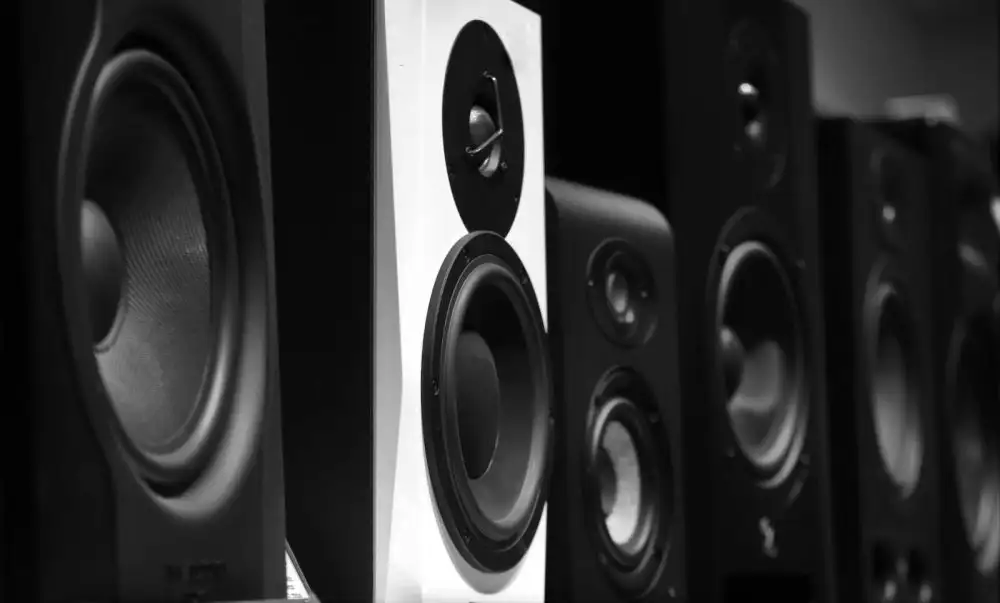Many people don’t know the difference between active and passive speakers. Many misconceptions exist about each speaker type, so let’s dive deeper to learn more! This article will answer all your questions about this topic, including active vs. passive speakers. Which one should you use for your business or home theater setup? What are the benefits and disadvantages? Finally, we will give you tips on choosing your speaker system.
What is an Active Speaker?
An active speaker includes a power amplifier built into it so that all you need for sound is a plug-in via Bluetooth or a line-in connection, making them perfect for PCs, laptops, tablets, and other devices. They’re also great for those who want high-quality audio without having anything else attached to their device, like receiver amplifiers, tweeters, or external subwoofers! The “downside” with this type of speaker is that you need a power outlet nearby.

What is a Passive Speaker?
A passive speaker does not include a built-in amplifier, so it will require external amplifiers and receivers to work correctly. This can be more complex than active speakers because many other things may interfere with their functionality. With this system, if one piece goes down or becomes disconnected, it affects the entire setup (for example, if your receiver malfunctions but still has sound from its subwoofer).
Active vs. passive speakers – Which One Should You Be Using?
Active speakers are great for those who want high-quality audio without complications; as long as you can plug into a USB port on your laptop or a nearby outlet, you’re good to go! They also work well in noisy and public environments since they don’t need other attachments.
Passive speakers are best for those who want to connect to other devices like receivers or subwoofers. They also allow a greater range of audio as they can turn up the volume and maintain its quality. The drawback of this type is that they require more power than active speakers to work!
Advantages of passive speakers
- Better sound quality and audio range: you can turn up the volume without sacrificing sound.
- This type of speaker system supports multiple connections and components, like receivers or subwoofers. An active speaker will not work because it has no other attachments!
- Easier to upgrade/replace: if you have a problem with one of your speakers, you only need to replace it instead of purchasing an entirely new system.
- Lighter weight and more straightforward design: these speakers are easier to carry around and can be set up much more quickly.
Disadvantages of passive speakers
- Requires more power than an active speaker.
- Signal loss is more common with this type of speaker system: a problem with one or two speakers can affect the whole setup.
- It requires external components like amplifiers and receivers to work correctly without any other interference from them, whereas an active speaker does not need anything else for it to function!

Advantages of active speakers
- No need for external components like receivers or amps: these speakers work on their own, and all you have to do is plug in your device.
- Low-power consumption with this speaker system is excellent if you don’t want anything else connected to your PC/laptop!
- The amp and speaker are designed to be used together so the sound is more optimized or tuned.
- The signal goes through a crossover before the amplifier, meaning the sound will stay much clearer.
- Easy wireless connection with Bluetooth: you can sit in the back row of a classroom and still be able to connect everything from your laptop or smartphone!
Disadvantages of active speakers
- Heavy due to the fact of having an amplifier built-in.
- Difficult to upgrade because it’s hard for you to replace or add just one speaker.
- Difficult to repair and may need an expert to get it working again, or the whole system needs to be sent for repair.
What is speaker polarity?
Speaker polarity refers to the positive and negative terminals on a speaker and how they correspond to the corresponding terminals on an amplifier. Each speaker has two input terminals, typically labeled with a + or ? symbol, or color-coded as red and black. It is vital to ensure that the positive (red) terminal on the speaker connects to the matching output terminal on the amplifier.
Maintaining correct polarity is important at both ends of the speaker cable, specifically at the speaker and amplifier connections. When connecting speakers to an amplifier, it is crucial to ensure that the positive and negative terminals are matched appropriately on both the left and right speaker channels. Failure to do so can result in one channel being out of phase with the other, causing problems with audio reproduction.
If the polarity is incorrect, it can lead to issues such as cancelation of audio signals at the listening position. This means that centrally positioned elements of the audio mix, such as bass, snare, and lead vocals, may cancel each other out, resulting in a compromised sound quality described as “thin.” To avoid these problems, it is necessary to pay attention to speaker polarity and correctly match the positive and negative terminals on both the speaker and amplifier ends.
Does the type of speaker wire matter?
The type of speaker wire you choose may seem like an important decision when setting up your audio system, but it’s essential to separate fact from marketing hype. While some specialty speaker cables claim to offer superior sound quality, it’s crucial to consider the scientific evidence behind these assertions.
Numerous studies have indicated that the type of speaker wire you use has minimal, if any, impact on sound performance. Expensive cables often come with promises of enhanced audio fidelity, but these claims are largely unsupported by scientific research. In fact, it has been demonstrated that even a basic, inexpensive cable can provide satisfactory sound quality when properly installed.
Rather than getting caught up in the marketing tactics of overpriced speaker cables, it is more prudent to focus on other factors that can have a more significant impact on your audio experience. For instance, ensuring that your speaker wires are not excessively long is crucial. By cutting them to the appropriate length once you have finalized your speaker placement, you can prevent unnecessary signal loss and interference.
Ultimately, the most important aspect of setting up your speaker system is achieving optimal speaker placement and ensuring that the wires are of sufficient gauge to handle the power requirements of your setup. As long as you use a reasonably sized wire and avoid excessive lengths, you can confidently prioritize other factors in your audio setup without worrying about the minute differences in speaker wire types.
What do you need to know when wiring multiple speakers to a single amplifier channel?
When wiring multiple speakers to a single amplifier channel, there are a few important factors to consider. One of the key things you need to know is how to calculate the combined impedance of all the speakers that are connected.
When speakers are connected in series, the impedance values simply add up. For example, if you have two 4-ohm speakers connected in series, the combined impedance would be 8 ohms. Similarly, two 6-ohm speakers in series would result in a combined impedance of 12 ohms.
On the other hand, connecting speakers in parallel is a bit more complicated. In this case, the impedance actually reduces for each additional speaker connected. To calculate the total impedance when speakers are connected in parallel, you can use the formula 1/total impedance = 1/impedance 1 + 1/impedance 2 + 1/impedance 3 + …
For example, if you have two 4-ohm speakers connected in parallel, their combined impedance would be 2 ohms. In a more complex scenario, where you have two 4-ohm speakers and one 6-ohm speaker connected in parallel, the total impedance would be 1.5 ohms.
Understanding the combined impedance is crucial because parallel connections can exert too much load on your amplifier, which may lead to overheating or even cause it to shut off.
Therefore, when wiring multiple speakers to a single amplifier channel, it is essential to calculate the combined impedance accurately to ensure the proper functioning of your audio system and prevent any potential damage.
Active vs. passive speakers – which one is right for you?
Based on the differences between active and passive speakers, it’s easy to see which is better for your needs. If you want a setup that requires less power than an active speaker would require but still wants high-quality sound, then go with a passive system! An important thing to remember is that if there is any problem with just one of these components, it will be easier to repair or replace.
If you’re looking for a setup that requires less power and is easier to assemble, active speakers are right! They work independently without any external components, making installation much more convenient. The only downside with these types is if there’s ever an issue with the speaker system, it may be challenging to repair.